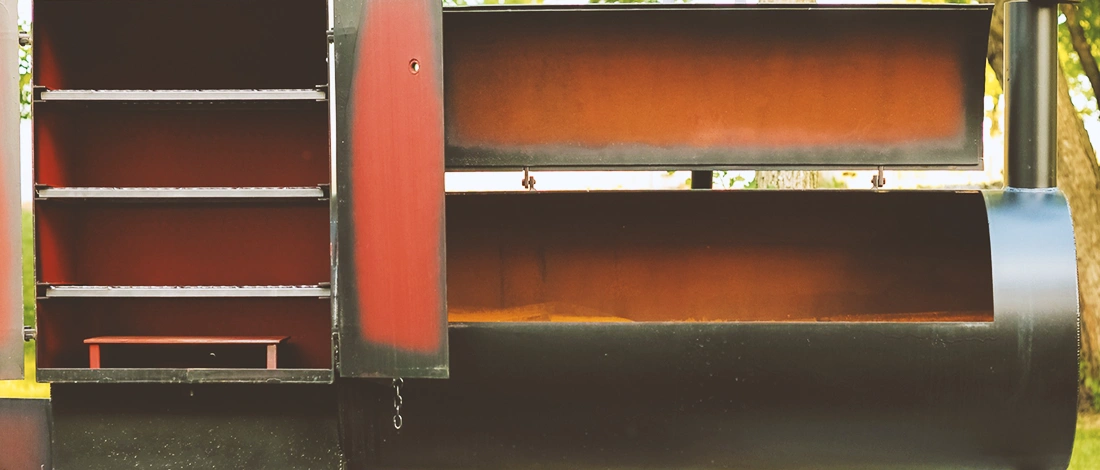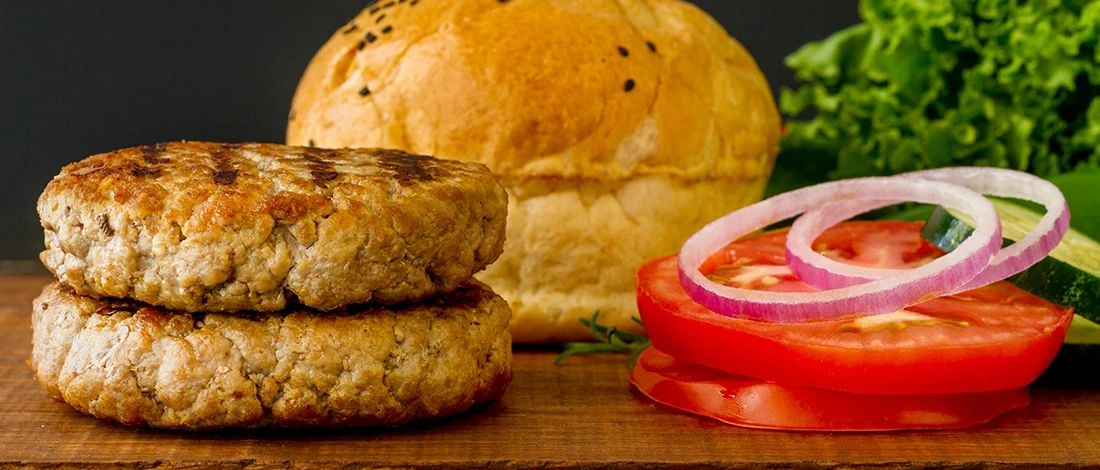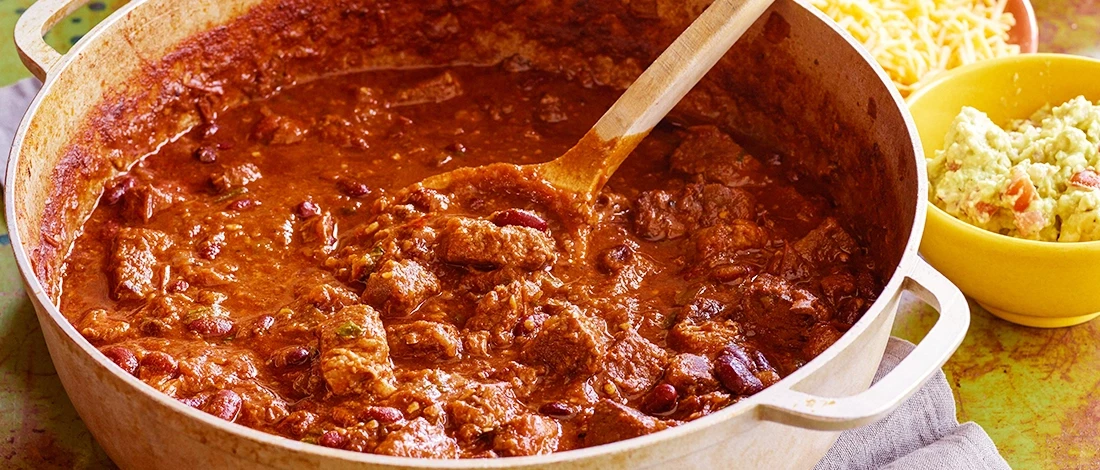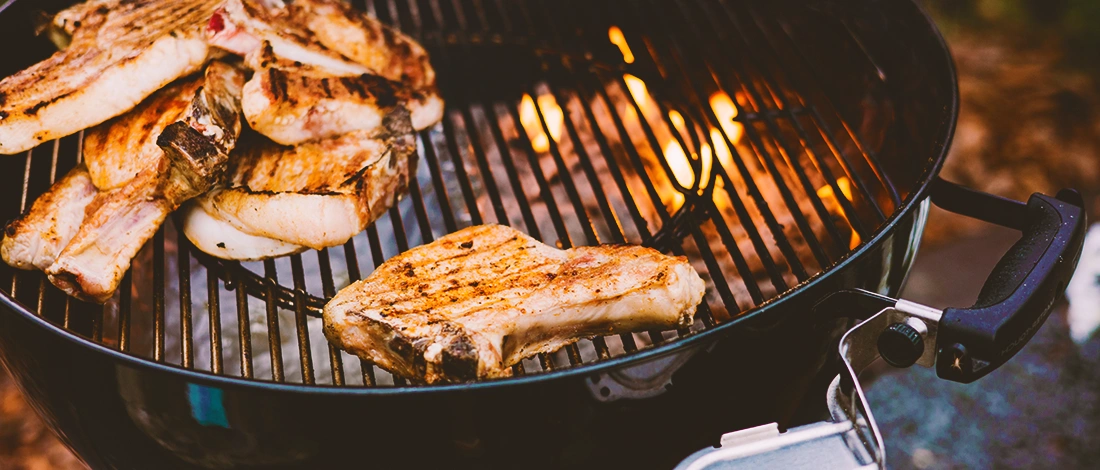A surefire way to dampen the spirits of a BBQ party is when a charcoal grill refuses to stay lit.
Regrettably, over the course of my ten-year grilling journey, I have encountered this predicament on more than a few occasions.
I spent countless hours looking for ways to keep a charcoal grill lit and experimented with various methods until I found what might be the problem.
Make sure to check our list of the best charcoal grills and see if you can find the right one for you.
Here’s my ultimate list of the 12 best ways how to keep a charcoal grill lit, so you’ll never again be faced with a cool grill in the middle of a grill session.
Quick Summary
- There are many reasons why your charcoal grill won’t remain lit.
- You should keep the grill clean and make sure there’s enough airflow so the charcoal stays lit.
- A 2012 study in PubMed found that the type of charcoal and grilling conditions significantly affect the formation of heterocyclic aromatic amines (HAs) and polycyclic aromatic hydrocarbons (PAHs) in grilled foods, with coconut shell charcoal presenting significantly lower amounts of these compounds compared to other methods [1].
- You need to know how to light the charcoals properly so that they stay hot for a long time.
12 Ways to Keep a Charcoal Grill Lit

Here’s what might be stopping your charcoal grill from staying lit.
1. Try Different Charcoal
There are many different kinds of charcoal you can get, and this determines if your grill will stay lit.
Some types of charcoal are easier to light and keep lit than others.
In case you’re struggling to maintain a charcoal grill fire, you should check what kind of charcoal you’re using.
Generally, all charcoal can be classified as:
- Lump - The most popular type. It’s made of pure or near-pure carbon.
- Briquettes - Made of wood and organic by-products joined with a binding agent.
Briquettes burn longer than lump charcoal, but they are more difficult to light and keep lit.
The 2013 NPR article explores the differences between using charcoal briquettes and lump charcoal for grilling, highlighting briquettes' consistent burn and lump charcoal's higher heat and flavor-enhancing wood varieties [2].
Pro tip: Charcoal with a high carbon content stays lit the longest.
Charcoal with a low carbon content, such as 50%, is cheaper but difficult to keep lit and produces low heat.
This is why it’s better to invest in more expensive charcoal.
2. More Oxygen
Fire needs air to burn. If your coals don’t have enough air, they won’t stay lit. Most grills have two dampers, which you use to control the airflow.
Check to ensure all dampers on your grill are open before lighting a grill. If they are closed, air can’t reach the charcoal, and the coals will burn out.
Pro tip: The more your vents are open, the hotter the grill.
Also, air vents on charcoal grills are usually small and can be blocked by ash, small lump charcoal, and briquettes.
If you struggle with keeping a grill lit, the issue can be a lack of ventilation.
Open the vents all the way at first and partially close them once you have hot charcoal, so the air can reach the coals and keep them hot.
Overall, keep the vents open when you start the fire, partially closed during cooking, and completely closed to extinguish the fire.
3. Stack the Charcoal Vertically
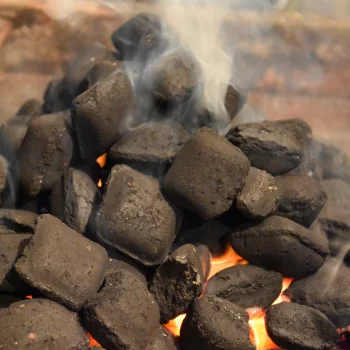
Another reason you can’t keep charcoal lit is that it’s not stacked properly.
If enough air can’t reach burning charcoal, it’ll die out. You should stack the charcoal vertically instead of arranging it flat on the grill.
Heat rises, so stacking charcoal lets heat rise from the bottom to the top coals.
Pro tip: Pile up charcoal, but leave some space between the lit charcoal so the air can slip through and fuel the flames.
4. Lighter Fluid
The most common way of starting up a charcoal grill is using lighter to light charcoals.
However, it’s tricky to use, and you can end up with charcoals that won’t stay lit if you don’t do it properly.
Here’s how to use lighter liquid for the best results:
- Arrange charcoals vertically. A pyramid shape works best.
- Pour lighter fluid over all coals, not only one spot. Be generous with dosing but don’t soak the coals.
- Wait half a minute for the coals to absorb the liquid, and use a matchstick to light them up. Don’t wait too long, or the lighter fluid will evaporate.
- When the coals catch fire, spread them with a stick and start grilling.
Note: Never add additional liquid after starting the fire, as this is a huge safety hazard.
Adding more liquid also accelerates the burning rate, and your grill won’t stay lit as long.
5. Clean the Grill
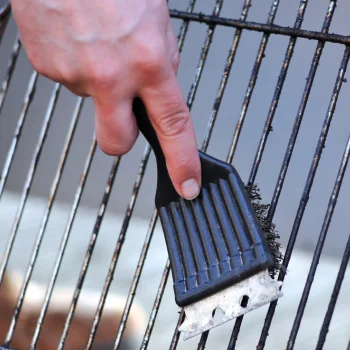
Another reason your grill won’t stay lit is dirt. You should clean the grill before and after using it.
Make sure there’s no water in the grill, and get rid of ashes as they retain moisture.
Moreover, too much ash restricts grill airflow by blocking the dampers. The airflow isn’t strong and stable enough, which prevents the coals from staying lit.
You should wait until the ashes cool after using the grill and shovel them into a bucket.
Also, use a wire brush and remove debris from the burners.
6. Use a Temperature Gauge
A temperature gauge is a great tool that can help your charcoal grill stay lit.
You can anticipate temperature changes in the fuel and track the heat levels during the entire cooking process.
A temperature probe lets you know the temperature is going down, so you can tend to the coals.
Overall, this is a smart investment that can help you keep a charcoal grill lit and at a specific temperature level.
7. Protect the Grill from the Weather
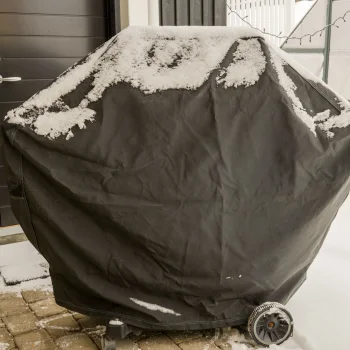
Weather conditions also affect if your charcoal can stay lit.
For example, humidity causes the charcoal to burn out. If it’s an especially humid day, moisture can saturate charcoal to the degree where it can’t stay lit.
While you can’t control how humid it is, you can take some precautions. Use dry charcoal and stack it vertically to ensure it stays lit.
Once your charcoal grill reaches a temperature from 450 to 600 degrees, humidity can’t make the charcoal go out.
Pro tip: Briquettes absorb more moisture, so it’s better to use lump charcoal when the weather is humid.
Wind can also cause charcoal to burn out. You should lower the grill’s lid for protection.
Leave a gap so the air can circulate. Lower the lid enough to block wind gusts without cutting off the air supply completely.
You can also place the charcoal grill in the windbreaker to block as much air as you can.
8. Use a Chimney Starter
A chimney starter is a cylindrical-shaped piece of metal with a hollow interior. You fill it with charcoal, put it on the grill, and light the bottom.
You have to wait 10 to 20 minutes for the quality charcoal to get hot, then dump it into the bottom of your smoker.
Or, you can keep the charcoal in the starter.
The coals are collected in a small space, which means they’ll burn longer and be protected from wind and water.
This device holds the charcoals tightly together, and the through draft provides oxygen to the flames. You can even use this method to light a larger pile of charcoal.
9. Open the Lid When Lighting
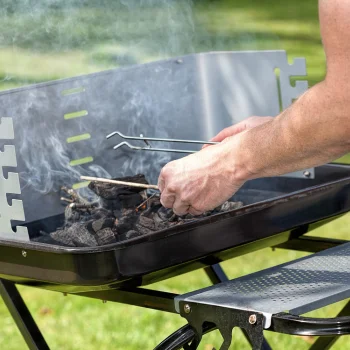
By now, you know how important air is for keeping charcoal burning.
If you close the lid too early, the charcoals will lose temperature and go out. You need to wait until all charcoal burns evenly.
Generally, you should close the lid when cooking thick steaks or large cuts of meat.
If you’re cooking smaller pieces, keep the lid open.
10. Keep Adding Charcoal
Use enough of the recommended charcoal briquettes to prevent the fire from dying out too fast. Don’t let the coals burn, but keep adding coals when half of the current ones are gone.
A general rule is to add coals every half an hour, although this depends on the exact coals you’re using.
Check the instructions on your charcoal package to find out how much coals you need for a certain grilling period.
Pro tip: Don’t continue cooking as soon as you add more coals. Give them about ten minutes to start burning before you continue grilling.
Also, more charcoals burn hotter, and you have a higher temperature.
11. Use Quality Wood

The type of charcoal you use is important but also is the cooking wood you use.
You should use quality wood chips with charcoals for the best flavor and consistent burn.
There’s a high range of wood you can use, such as apple, hickory, cherry, and more.
Whichever you prefer, make sure it’s high quality.
Seasoned wood has a high moisture content, which lowers the heat and leads to musty, stale smoke that doesn’t create good taste.
"If you use pine, that would burn fast and hot — good for searing a steak. But if you want a slower cook, you'll want charcoal made from a higher density wood like oak or hickory."
- Adam Downing, Virginia Extension Officer
Also, soaking wood before using it may seem like a good idea, but this means adding more water to the coals, which can prevent them from staying lit.
It’s best to use dry wood chunks, as they ignite quickly and help the fire stay alive.
Pro tip: It’s important to get the timing just right. Add wood chunks when the charcoal turns white-hot, as wood won’t smother the charcoal at this time.
12. Create Two Zones
The final tip on keeping your charcoal grill lit also regards lighting charcoal. You should create two zones on the grill.
Stack the lit coals or use a charcoal chimney on one side of the grill and leave the other side empty.
The heat from the side with the charcoals will cook the food on the other side at a lower temperature at indirect heat.
This method also lets you move the food from one zone to another, which is useful when moving the food off direct heat and stoking the coals.
It also means you can cook different types of meat at the same time.
How to Light Charcoal to Keep It Lit?

Here’s how to light charcoal to keep it lit:
- Newspaper - Crumple some newspaper and put it on the bottom of the grill. You need about five balls.
- Use pine needles or wood - Place them on top of the paper. Make sure they are dry.
- Add charcoal - Place the charcoal on top of the newspaper balls.
- Light it - Use a grill lighter and light the paper. If the paper extinguishes before the charcoal can catch on fire, add more balls.
- Add charcoal - Once the first charcoals have caught on fire, add more charcoals. Stack quality charcoal for the best results. Add cooking wood chips for extra flavor.
- Add food - When there’s a flame coming out from the charcoal grate, it’s time to add food to the grill grates.
FAQs
How Long Will a Charcoal Grill Stay Lit?
How long a charcoal grill will stay lit depends on the type of charcoal you use. Lump charcoal stays lit for up to six hours, and briquettes can stay lit for up to 10 hours.
How Long Does Charcoal Say Active?
Charcoal stays active indefinitely if stored in a cool and dry place. You should keep charcoal in an airtight container until use.
Do You Just Let a Charcoal Grill Burn Out?
Yes, you just let a charcoal grill burn out. This is the best way to put out a charcoal grill. Make sure to keep the lid and vents closed shut.
Can You Mix Briquettes with Lump?
It is possible to mix the lump with the briquettes charcoal. Since each type has its own unique strengths, you can combine them to find a good balance.
References:
- https://pubmed.ncbi.nlm.nih.gov/22459130/
- https://www.npr.org/sections/thesalt/2013/05/24/186434261/the-great-charcoal-debate


